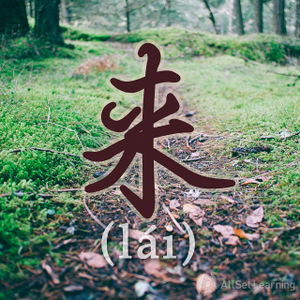Direction complement "-qilai"
-
Level
-
Similar to
-
Used for
-
Keywords
起来 (qǐlái) comes up very frequently in Chinese and can be used both literally and figuratively. This is a little like the usage of "up" in English, which can be used literally, as in "stand up," or figuratively, as in "add up." When used figuratively, 起来 often serves as a direction complement.
Contents
Basic Meaning
Structure
起来 can be used to express an upward movement like "up," as in the English examples of "stand up" or "pick up."
Verb + 起来
Examples
- 请 大家 站 起来 。Everyone, please stand up.
- 捡 起来。Pick it up (from the floor).
- 头 抬 起来 。Raise your head.
- 别动 !把 手 举 起来 。Don't move! Put your hands up.
Used for Initiation of an Action
Structure
起来 can also be used to show that an action or state has started and is ongoing:
Verb / Adj. + 起来 +了
Examples
- 小鸟 飞 起来 了 。The birds started flying.
- 宝宝 哭 起来 了 。The baby started crying.
- 两 个 大妈 吵 起来 了 。Two middle-aged ladies started arguing.
- 天气 热 起来 了 。It's getting hot.
- 结婚 以后 ,她 胖 起来 了 。After she got married, she has started to gain weight.
- 爷爷 的 身体 好 起来 了 。Grandpa's health is getting better.
When used like this, 起来 is only used with spontaneous actions, like 唱 (chàng), 跳 (tiào), 聊 (liáo), or with states like 热 (rè), 冷 (lěng), or 好 (hǎo) etc. It cannot be used with planned actions.
- 你 几 点 工作 起来 ?
- 你 几 点 开始 工作 ?What time will you start working?
It can also used as a way to encourage people to start doing something immediately:
- 大家 唱 起来 ,跳 起来 ! Let's sing and dance, everybody!
Used for an Initial Judgement
起来 is used here to express that the speaker has only just initiated an action, and based on that, has made a preliminary judgment. It is used in the following structure:
Structure
Subj. + Verb + 起来 + Adv. + Adj.
This expresses that the subject seems adjective when the action of the verb is performed. This structure is frequently used with perception verbs such as 看, 听, 闻, 摸, etc.
Examples
- 他 看 起来 很 友好 。He looks very friendly.
- 你 的 头发 闻 起来 很 香 。Your hair smells good.
- 这 件 事情 听 起来 有点 复杂 。This matter sounds a little bit complex.
- 这些 菜 尝 起来 都 不错 。These foods all taste good.
- 你 的 床 摸 起来 很 舒服 。Your bed feels very comfortable.
See also
- Result complement "xiaqu"
- Advanced result complements
- Direction complement
- Appearance with "kanqilai"
Sources and further reading
Books
- Chinese Grammar - Broken down into 100 items - Basic and Intermediate Levels (汉语语法百项讲练 - 初中级) (pp. 25-31) Anything Goes (无所不谈) →buy
- Boya Chinese Elementary Starter 2 (博雅汉语初经起步篇) (pp. 80) Anything Goes (无所不谈) →buy
- New Practical Chinese Reader 5 (新实用汉语课本5) (pp. 134-5) Anything Goes (无所不谈) →buy
- 40 Lessons for Basic Chinese Course (基础汉语40课下册) (pp. 355-6) [ →buy]
- Integrated Chinese: Level 2, Part 2 (pp. 20) Anything Goes (无所不谈) →buy
- HSK Standard Course 4下 (pp. 60) Anything Goes (无所不谈) →buy
- HSK Standard Course 5上 (pp. 36) Anything Goes (无所不谈) →buy
Websites



